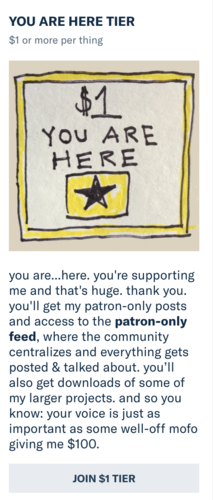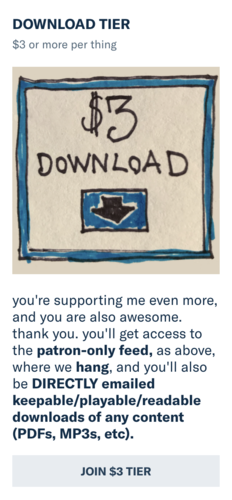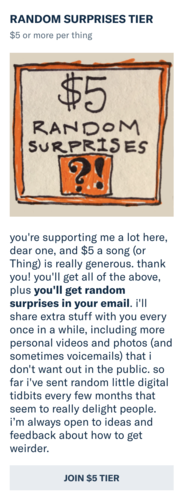Four things you can learn about regular giving from Amanda F*cking Palmer
By Caoileann Appleby - Jul 30 2018
Since I first tried crowdfunding with ASN in 2013, I’ve noticed more and more charities exploring it as a fundraising technique. Which is not surprising, because – as I learned from Aditi Srivastav in 2014 - it’s not really that new.
And as Amanda Palmer says:
“All fundraising is crowdfunding…. You just need to find YOUR crowd”
If you weren’t lucky enough to catch her at IFC in 2016, or haven’t watched her TED talk The Art of Asking, or read her book of the same name – you should! Palmer is also somewhat famous for her record-breaking Kickstarter campaign. But she’s left Kickstarter behind and has been funding her art through Patreon for a few years now.
What’s Patreon?
It’s often called crowdfunding platform, because it’s online; but really it’s a new face on a form of giving us fundraisers are very familiar with – regular giving.
And I think there’s something for us individual giving specialists to learn from what makes it such a powerful vehicle for artists like Palmer.
Control + flexibility = surprise + delight
On Patreon, I have total control about how much to give a month: I can also give per item produced (“per Thing” in Palmer’s parlance). So if I give $5 per Thing, and she makes two Things, I pay $10 that month; if none, then I pay nothing.
What if the artist has an amazing creative spurt and releases 10 Things in one month?
No problem. I can also cap the monthly amount so I never pay more a month than, say, $15, but I get access to all the Things released that month. If I want to change how I’m giving, or how much, I simply log in to Patreon.
Not only do I get flexibility, so does the artist. Because most patrons are monthly supporters, with a base level of income, the artist is free to experiment more.
Case in point: Last year Palmer released an album with another musician, Edward Ka-Spel. I bought tickets for their album tour when it came to London. I have to confess – I hated it. It’s one of the only music gigs or performances of any kind that I’ve left before the end. The album was just not my thing.
Was I annoyed? Slightly. Did it make me cancel my Patreon payment? Not even close. Because not only did I understand that not every Thing Palmer produces is going to be my kind of thing, that album also led to one of my favourite Things: a short story by Lauren Beukes to accompany one of the songs on the album – exclusive for Patrons. And that, I love!
Another of my favourite Things is a music video, one recorded when Palmer and her supporting artists were rehearsing a cover song. Their families were there, too. And one musician’s wife started to dance to the music, with another’s baby. Contemporary dance is not my kind of thing, at all. If Palmer had asked me to support a contemporary dance video for a song – just a cover, not even her own! – I would 100% not have clicked on a ‘donate’ link. But – surprise! I loved it. And I loved how I could be surprised by what Palmer does with my support.
On Patreon, I decide how much to give; the artist has complete freedom to do what she likes with my money. As a charity, how much more trust would you get – how much new work could you try that you’re not doing now – if you could give that kind of flexibility to your donors?
Give more, get more
In the charity sector, regular income is the holy grail: and in individual giving in particular, regular givers are incredibly valuable. We spend a lot recruiting them through face to face, Facebook, and DRTV, and we also try to upgrade them – get them to increase the value of their donation – regularly.
Our charity needs us to keep their donations unrestricted so it can fund flexibly, but it means that, when it comes to upgrading, we are often left with a proposition that’s pretty weak from the donor’s point of view.
Why should they give us more money? Well, because we need them to.
Can we do better?
There are lots of techniques you can use to upgrade donors better than you have before (get in touch! #shamelessplug), but it’s not easy to find an upgrade campaign that offers regular givers a really compelling reason to upgrade.
On Patreon, when you choose a level of support, you know exactly what you’ll get for your money. And you know that if you give more, you get more. It’s all right there on the page.




What if we were this transparent with our regular donors? What if we could offer them different levels of rewards or access depending on their giving level? The possibilities depend on your charity, but might that be a more compelling reason to upgrade than simply “we need more money”?
It’s all about authenticity…
You might be saying, okay, that might work for creators, but that’s still essentially a transactional relationship. Our donors don’t want that from us. They want to know they’re doing good; they want the warm fuzzies; they’re not buying stuff, they’re buying change.
You’re absolutely right.
But as a patron, I’m not just buying stuff. I’m buying experiences –and access to the “inside track”. Patreon creators are giving their patrons more engagement, not less.
Amanda Palmer not only offers presale tickets to her patrons (something that many creators offer through their email lists or Spotify fanpages), but also runs exclusive patron-only gigs. Her Patreon was the first place she told her fans about her recent miscarriage. She also tells us when she’s having a boring day answering emails. She crowdsources song lyrics, gig ideas and video extras from among her patrons: something she’s done for years, but facilitated more easily by Patreon.
What if we tried showing our regular donors the impact of their support and how it helps month by month – warts and all? The highs, and the lows? The child vaccinated as well as the week the vaccines didn’t get through because of terrible roads; the dog we saved as well as the one we didn’t get to in time; the exciting research as well as the experiment that failed? What if we asked for their thoughts and advice as well as their support?
…but stuff is good too
Just ask this donor from our most recent piece of research:
“I’m being absolutely bombarded by emails about other things. I get about 20 or 30 emails a day, I get very few letters so that’s why I’d prefer to get letters than emails.” – animal charity regular donor
When Amanda Palmer wanted to up her patron numbers beyond her usual 300-400 new patrons per month, she tried something new: she offered a unique thank-you card to any patron who wanted one – whatever amount you supported at – and the results were pretty astonishing:
They expected about 3,000 patrons to take them up on the offer. Instead, they got 9,000 requests!
And 2,540 people become patrons for the first time that month (that’s a ~500% increase on the usual numbers).
Since it was a one-time offer, it was possible that many fans would sign up as patrons just to get the card, then bail. But the team was pleasantly surprised that out of all the patrons who came for the card, 87% stayed to support Amanda long-term.
People like physical things they can hold in their hands. When you give, you get (incentives work, yo! Ask us how we know #anothershamelessplug).
None of this is to say this way of doing regular giving is easy. It’s not. And the best fundraising is not about the easy. It’s often about the simple: doing the simple things well, over and over again. But most of all, it’s about what’s effective. And as a supporter and a fundraiser, Patreon is fast-becoming one of my favourite ways to give back and get back.
If you want to add to the conversation or chat about your regular giving, get in touch at caoileann@askdirect.ie.
Main image of Amanda Palmer at IFC 2016 by Howard Lake, c/o Wikimedia Commons.
Caoileann Appleby @Qaoileann
